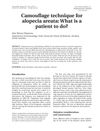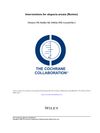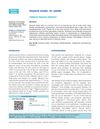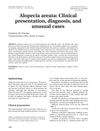TLDR The document concludes that alopecia areata is an autoimmune disease without a definitive cure, but treatments like corticosteroids are commonly used.
The 2013 document provides a comprehensive update on alopecia areata (AA), detailing its etiology, clinical presentation, diagnosis, and treatment options. AA is identified as an autoimmune condition with genetic predisposition and potential environmental triggers. It affects both genders equally and is most prevalent between ages 30-59. Diagnosis is aided by scalp biopsies and dermoscopy, while the SALT score helps assess severity. Spontaneous hair regrowth is common, but prognosis worsens with factors like early onset and associated autoimmune diseases. Treatments include corticosteroids, minoxidil, anthralin, immunotherapy, and phototherapy, but a Cochrane review highlights the lack of definitive cures. Topical immunotherapy with DPCP and phototherapy show variable success, and while some new treatments are under investigation, corticosteroids remain the primary therapy. The document underscores the need for controlled studies to establish effective treatments for AA.
67 citations
,
July 2011 in “Clinical, cosmetic and investigational dermatology” The document suggests a personalized treatment plan for alopecia areata based on the patient's age and hair loss severity, using a range of therapies ranked by effectiveness and safety.
 19 citations
,
May 2011 in “Dermatologic Therapy”
19 citations
,
May 2011 in “Dermatologic Therapy” The document suggests using hairpieces, wigs, and safe cosmetic techniques to hide hair loss from alopecia areata.
44 citations
,
October 2009 in “Journal of the American Academy of Dermatology” Topical bexarotene 1% gel might help regrow hair in alopecia areata and is generally safe.
 164 citations
,
April 2008 in “Cochrane library”
164 citations
,
April 2008 in “Cochrane library” Current treatments for alopecia show no significant long-term benefits.
 3 citations
,
June 2020 in “Cureus”
3 citations
,
June 2020 in “Cureus” A woman's hair loss led to discovering she had lupus.
1 citations
,
January 2015 in “General Medicine” Vitiligo and alopecia areata might be early signs of Type 1 Diabetes.
12 citations
,
January 2014 in “Dermatology online journal” White hair regrowth in alopecia areata may be more common than thought.
 67 citations
,
January 2013 in “Indian Journal of Dermatology, Venereology and Leprology”
67 citations
,
January 2013 in “Indian Journal of Dermatology, Venereology and Leprology” The document concludes that alopecia areata is an autoimmune disease without a definitive cure, but treatments like corticosteroids are commonly used.
 109 citations
,
May 2011 in “Dermatologic Therapy”
109 citations
,
May 2011 in “Dermatologic Therapy” Alopecia areata is a type of hair loss that can lead to complete baldness, often associated with other autoimmune conditions, and half of the cases may see hair return within a year.
1 citations
,
April 1990 in “PubMed” Alopecia areata causes unpredictable hair loss and is hard to treat.






